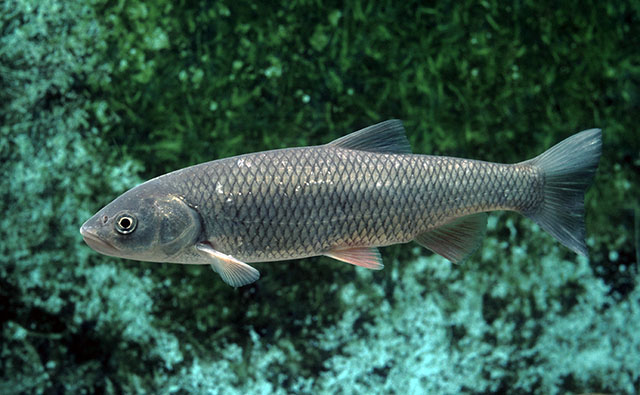| Leuciscidae (Minnows), subfamily: Leuciscinae |
| 60 cm SL (male/unsexed); max.weight: 8,000.0 g; max. reported age: 22 years |
|
benthopelagic; freshwater; brackish; pH range: 6 - 7.80000019073486; dH range: 8 - 25; depth range - 0 m, potamodromous |
| Eurasia: North, Baltic, northern Black, White, Barents and Caspian Sea basins, Atlatinc basins southward to Adour drainages (France), Great Britain north to 56°C, Scandinavia: southern Finland, Sweden north to abut Stockholm. Mediterranean basin from Var to Hérault (possibly Aude) (France) drainages. Introduced elsewhere, Naturally absent from Italy and Adriatic basin. |
|
Dorsal spines (total): 3-3; Dorsal soft rays (total): 7-9; Anal spines: 3-3; Anal soft rays: 7-10; Vertebrae: 42-48. Differs from its congeners in France, North, Baltic, Arctic, Black and Caspian Sea basins by the possession of the following characters: dorsal profile with a well-marked discontinuity between head and trunk; a row of black pigments along free margin of each flank scale, forming a regular reticulate pattern, with no or very few pigments on central part of scales; anal and pelvic fins orange to red; dorsal fin with 8½ branched rays; anal fin with 8½ branched rays (rarely 9½); scales on lateral line 40-45 + 2-3; mouth terminal, with well marked chin; lower jaw tip not included in the upper lip; interorbital distance 37-42% HL; postorbital distance 47-51% HL; eye diameter 17-22% HL, 1.5-2.3 times in snout length; body depth 22-27% SL; lower jaw long, length greater than depth of operculum; iris whitish; pharyngeal teeth 2,5-5,2; in stretched anal fin of individuals larger than about 15 cm SL, distance between tips of first and last branched rays usually greater than caudal peduncle depth (Ref. 59043). Caudal fin with 19 rays (Ref. 2196). |
| Most abundant in small rivers and large streams of barbel zone with riffles and pools. Found along shores of slow-flowing lowland rivers, even in very small mountain streams, and in large lake, undertaking spawning migration to inflowing streams. Adults are solitary while juveniles occur in groups. Feeding larvae and juveniles live in very shallow shoreline habitats. Feed on a wide variety of aquatic and terrestrial animals and plant material. Large individuals prey predominantly on fishes. Breed in fast-flowing water above gravel bottom, rarely among submerged vegetation. Often form fertile hybrids with Alburnus alburnus (Ref. 59043). Popular with amateur sport fishermen. Can be caught with various baits and lures. The flesh is of poor quality (Ref. 38587). |
|
Least Concern (LC); Date assessed: 29 May 2022 Ref. (130435)
|
| harmless |
Source and more info: www.fishbase.org. For personal, classroom, and other internal use only. Not for publication.
